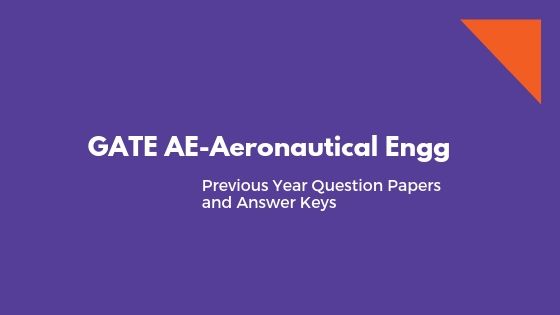Graduate Aptitude Test in Engineering (GATE) is an all India examination jointly by the IISc (Indian Institute of Science) and the seven IITs(Indian Institutes of Technology) on behalf of the National Coordination Board – GATE, Department of Higher Education, Ministry of Human Resource Development (MHRD), Government of India.
The score of GATE examination can be used by the students for admissions to various post-graduate programmes like M.E., M.Tech. These scores are valid for three years post announcement of results. The score may also be used by Public sector units for the purpose of employment screening.
AE is one of the important subject for GATE examination. Refer the below provided syllabus and Question Papers to understand the subject better.
About GATE 2020 AE Exam:
The GATE 2020 examination is for 3 hours and the question paper consist of 65 questions for a total of 100 marks. The mode of examination is ONLINE and at the end of the stipulated time (3-hours), computer will automatically close the screen putting an end to the particular examination.
Pattern of the AE GATE 2020 Question Paper:
The GATE 2019 Aerospace Engineering Exam Paper would contain 25 Questions of 1-mark each and 30 questions of 2-marks each. Out of the 65 questions asked, 10 questions would be General Aptitude and the rest 55 would be subject based questions.
The exam contains two different types of questions:
(i) Multiple Choice Questions (MCQ)
Each MCQ would carry 1 or 2 marks each in all the papers and sections. These questions are objective in nature, and each will have a choice of four answers, out of which the candidate must choose the correct answer. Note that there will be negative marking for a wrongly selected answer.
(ii) Numerical Answer Type (NAT) Questions
Each NAT question carry 1 or 2 marks each in all the papers and sections. For these questions, the answer is a signed real number, which needs to be entered by the candidate using the virtual numeric keypad on the monitor (keyboard of the computer will be disabled). No choices will be shown for these types of questions. The answer can be a number such as 10 or -10 (an integer only). The answer may be in decimals as well. There is no negative marking for a wrong answer in NAT questions.
GATE 2020 AE Syllabus:
The topics are divided into two categories:-
- Core Topics
- Special Topics.
The question paper will contain 90% of questions on Core Topics and the remaining 10% on Special Topics.
Section1: Engineering Mathematics
Core Topics:
Linear Algebra: Vector algebra, Matrix algebra, systems of linear equations, Calculus: Functions of single variable, limits, continuity and differentiability, mean value theorem, chain rule, partial derivatives, maxima and minima, Integration, Line, surface and volume integrals.
Special Topics:
Fourier Series, Numerical methods for linear and nonlinear algebraic equations, Laplace Transforms.
Section 2: Flight Mechanics
Core Topics:
- Basics: Atmosphere, Classification of aircraft
- Airplane performance: Pressure altitude; equivalent, calibrated, indicated air speeds; Primary flight instruments, load factor, turning flight, V-n diagram and .Winds
- Static stability: Angle of attack, sideslip; roll, pitch & yaw controls; Wing dihedral, hinge moments, stick forces
Special Topics:
- Dynamic stability; decoupling of longitudinal and lateral-directional dynamics; longitudinal modes; lateral-directional modes.
Section 3: Space Dynamics
Core Topics:
Central force motion, determination of trajectory and orbital period in simple cases.
Special Topics:
Orbit transfer, in-plane and out-of-plane.
Section 4: Aerodynamics
Core Topics:
Basic Fluid Mechanics: Conservation laws, Potential flow theoryViscosity, Reynolds number.
Airfoils and wings: Airfoil nomenclature; Aerodynamic coefficients, Kutta-Joukoswki theorem; Thin airfoil theory, Finite wing theory.
Compressible Flows: Conservation equations; One dimensional compressible flows, Fanno flow, Rayleigh flow; Isentropic flows, normal and oblique shocks, Prandtl-Meyer flow.
Special Topics:
- Elementary ideas of viscous flows including boundary layers; Wind Tunnel Testing.
Section 5: Structures
Core Topics:
Strength of Materials: Mohr’s Circle, Principal stresses, Three-dimensional Hooke’s law. Plane stress and strain; Failure theories, Analysis of statically determinate and indeterminate trusses and beams.
Flight vehicle structures: Characteristics of aircraft structures and materials. Torsion, bending and flexural shear of thin-walled sections. Loads on aircraft.
Structural Dynamics: Free and forced vibrations of undamped and damped SDOF systems. Free vibrations of undamped 2-DOF systems.
Special Topics:
Vibration of beams, Theory of elasticity, Airy’s stress function.
Section 6: Propulsion
Core Topics:
Basics: Thermodynamics, boundary layers and heat transfer and combustion
thermochemistry.
Thermodynamics of aircraft engines: Thrust, Aerothermodynamics of non-rotating propulsion components
Axial compressors: Angular momentum, efficiency of the compressor and degree of reaction.
Axial turbines: Axial turbine stage efficiency
Centrifugal compressor: Centrifugal compressor stage dynamics, inducer, impeller and diffuser.
Rocket propulsion: Thrust equation and specific impulse, vehicle acceleration, Classification of chemical rockets, performance of solid and liquid propellant rockets.
No Special Topics
For the complete detailed syllabus click on the link given below:
Last 10 Year GATE AE Solved Papers
Reference to the previous year’s Question Papers would help the student to understand the subject better and score good marks in the upcoming examination.
Last 12 years GATE AE Question Papers are provided in the links below:
| Sl. No | Year of GATE AE Exam | Download Link of solved paper |
| 1 | 2019 | Download |
| 1 | 2018 | Download |
| 2 | 2017 | Download |
| 3 | 2016 | Download |
| 4 | 2007 – 2015 | Download |

Hello can you please send the question papers to my mail address ?